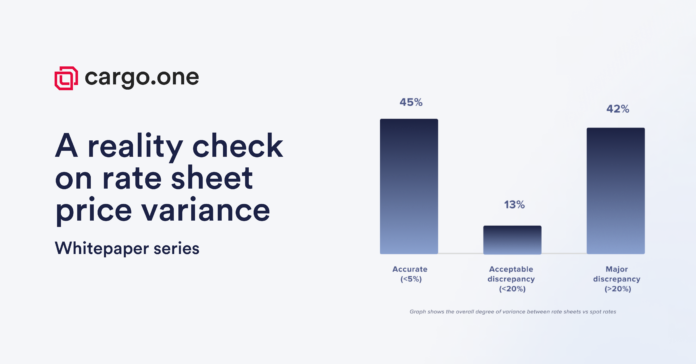

Rate sheets have long served as a convenient way to obtain a rapid price overview for a shipment. However, rate sheets can be compiled by airlines months before and in the face of an increasingly dynamic and unpredictable market, their effectiveness is now under scrutiny.
Digital booking platform cargo.one recently released a study that it hopes will help freight forwarders to bolster their rate intelligence. The data analysed the market prices for 10,000 origin and destination pairs in order to examine the degree of variance between rate sheets and available spot rates for the same shipment. Air Cargo Week sat down with the study’s author Victor Landau, VP Product at cargo.one, to explore the key findings.
Studying rate sheets
“Rate sheets have been an important mainstay of airfreight quoting for decades, but their reliability and practicality have increasingly been in discussion in the forwarding community. As cargo.one is a very analytical, data-driven team, we were keen to investigate what price trajectory data could inform us all on the issue.
Our study examined almost one million data points of rate sheets and available dynamic spot rates from our huge breadth of market offer data, across a sample of our airline partners. We analysed the extent to which rate sheet prices diverge from available spot rates. This is quite unique research and it’s an important topic for forwarders in relation to how they rate set and quote, particularly if their win rate is suffering as a result.”
READ: Propelling digital sales across Asia
Key trends
“While rate sheets provide a ballpark figure for rates, these can often be inaccurate, usually on the side of overpricing. Firstly, rate sheets can be up to 1000% deviated from spot rates around one week before departure. For example, 40% of the time, rate sheet rates will be more than 50 cents / kg different from the dynamic rates available in the market. Some 60% of the time, rate sheet prices will be more expensive than spot rates, and in 28% of the time, they will be more than 1 Euro / kg more expensive.
“Secondly, airline choice, weight break and time to latest acceptance time are big factors in the divergence of rates. The data underlines that contrary to the general perception with forwarders, some airline rate sheets are a lot more reliable than others. Even among the largest and most agile and equipped airlines, the extent of price deviation between rate types was very different.
“Freight forwarders need resources to sharpen their market view and better predict the actual rates required. They are likely to be uncompetitive if their quoting does not follow prevailing market rates more closely.”
Recommendations
“Our study also tested cargo.one’s new live estimates rate guidance feature to the exact same level as we did rate sheets. These rates use back testing against actual recent searches, and actual rate sheets to derive a substantiated estimate of the best market rate for a shipment. Live estimate rates are within a 20% difference of the actual available spot rate some 85% of the time, while rate sheets are that close only 58% of the time.
“We found that live estimates hold strong accuracy that is agnostic of specific airline or the time from LAT, and they can handle a large volume of quoting requests. This makes these a valuable resource for quoting agents to draw upon.”
READ: cargo.one announces landmark partnership with Eastern Air Logistics
Different approach
“Above all, the data shows that forwarders have much to gain in general from increasing their visibility and usage of spot rates. However, spot rates alone also have their drawbacks – requiring tens of seconds to load, which can restrict the process of generating quotes at speed.
Forwarders clearly need access to a solution that combines the convenience of rate sheets with the accuracy of live spot rates. Within their daily rate intelligence, I advise agents to combine rate sheets, live estimates and live spot rates, to achieve the optimal balance for scale and speed, and allow cross validation between rate sheets and market data. This approach will deliver far stronger accuracy for quoting.”










